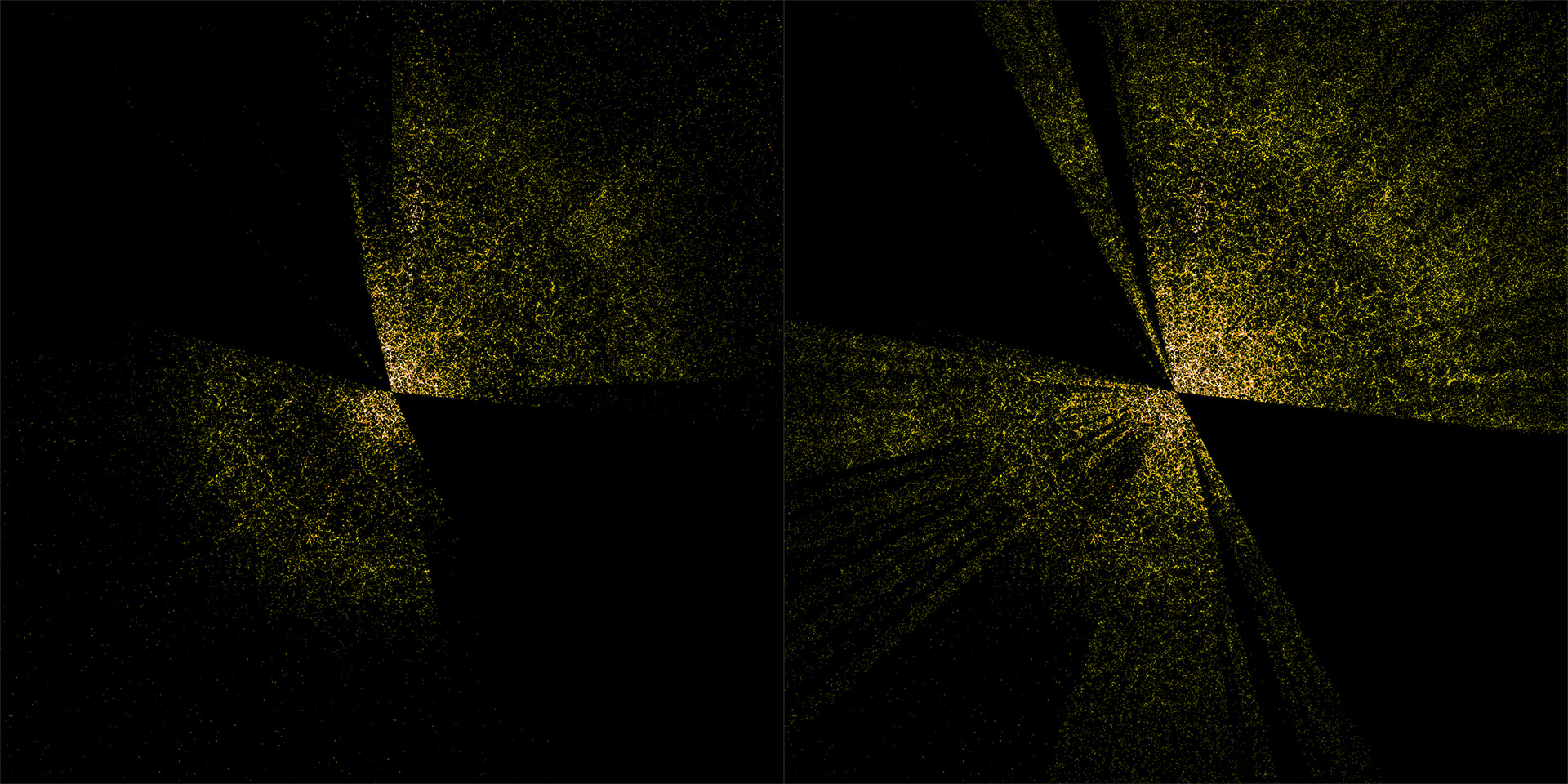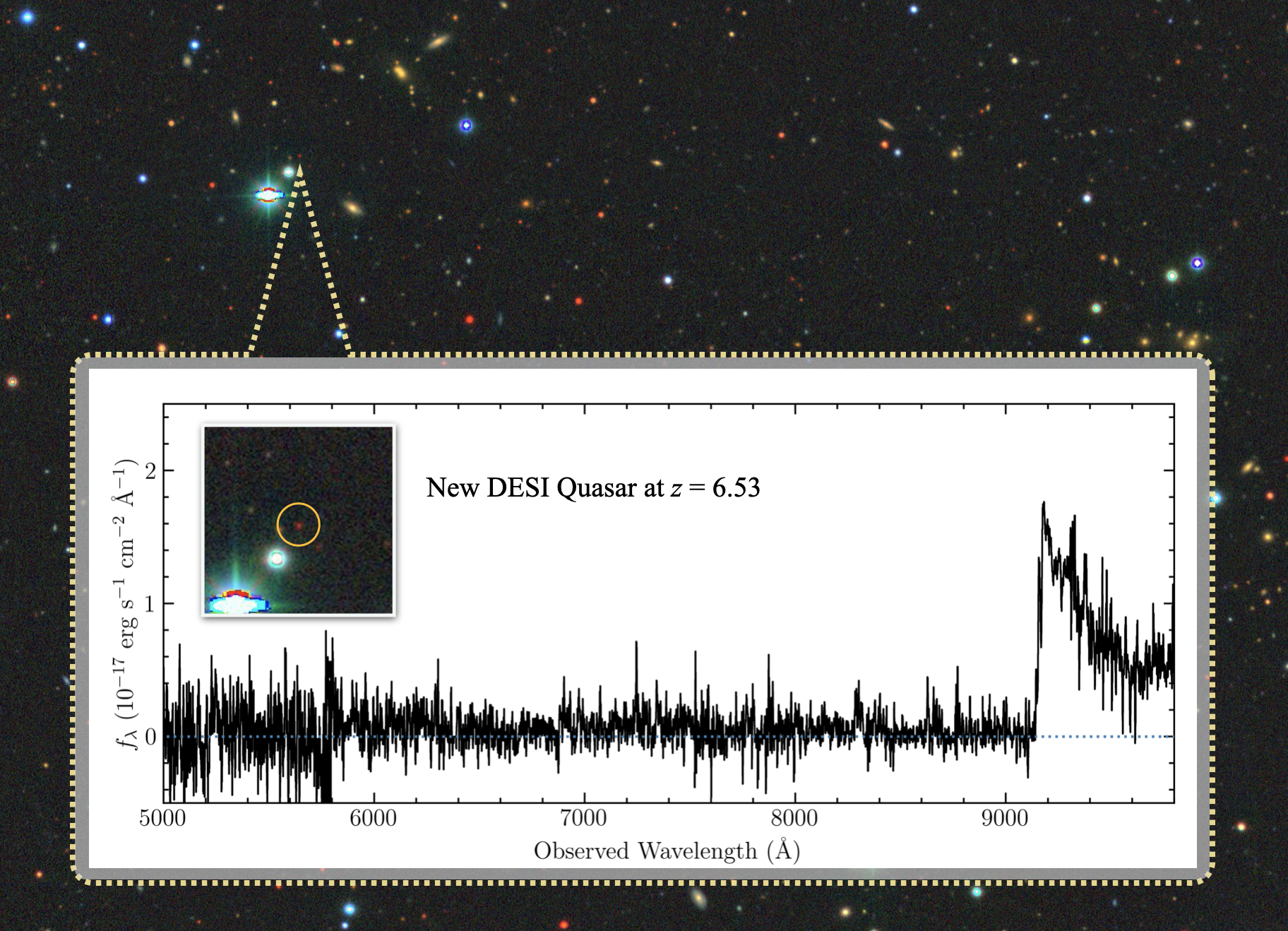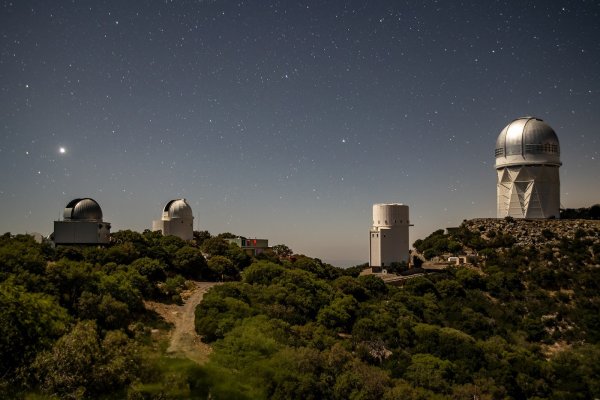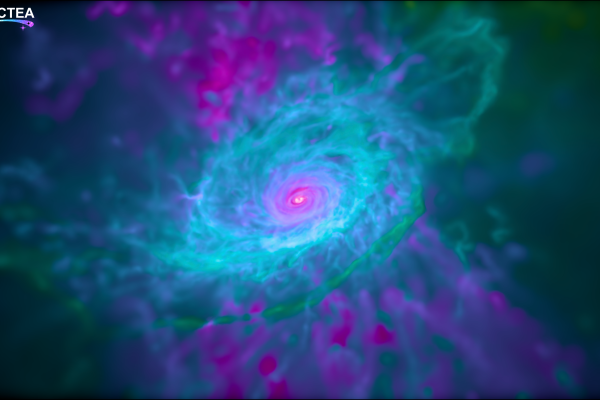DESI has already mapped out more galaxies than all previous 3-D surveys combined — and it’s just getting started. Several Spanish institutions are part of this project: IFAE, ICE-CSIC, ICCUB, CIEMAT and IFT/UAM.
The Dark Energy Spectroscopic Instrument (DESI) has capped off the first seven months of its survey run by smashing through all previous records for three-dimensional galaxy surveys, creating the largest and most detailed map of the universe ever. Yet it’s only about 10% of the way through its five-year mission.
Once completed, that phenomenally detailed 3-D map will yield a better understanding of dark energy, and thereby give physicists and astronomers a better understanding of the past—and future—of the universe. Meanwhile, the impressive technical performance and literally cosmic achievements of the survey thus far are helping scientists reveal the secrets of the most powerful sources of light in the universe.

Credit: D. Schlegel/Berkeley Lab using data from DESI
DESI is an international science collaboration managed by the Department of Energy’s Lawrence Berkeley National Laboratory (Berkeley Lab), in which many Spanish research centres participate among numerous other institutions world-wide.
DESI scientists are presenting the performance of the instrument, and some early astrophysics results, during a series of especial online seminars, which will also include a presentation of the current situation of other cutting-edge cosmological experiments. More than a dozen talks and papers are scheduled, and the presenters are excited to share the first results from this landmark survey.
“DESI began measuring the distances to galaxies in March, 2021, and over these months it has managed to exceed the numbers of the previous mappings. The system of 5000 robotic fibers of the telescope is allowing the increase of cosmological precision to unprecedented limits,” says Autonomous University of Madrid researcher, Violeta González Pérez.
“It’s very exciting”, says Marc Manera, researcher at the Institute for High Energy Physics of Barcelona (IFAE), “we can 3D-map the galaxy distribution in very high detail, and see its filamentary structure, clusters and void regions. DESI has come a long way to get to this point. It takes five years just to obtain and validate the images from which the galaxies are selected”.
DESI was originally proposed over a decade ago, and construction on the instrument started in 2015. It was installed at the Nicholas U. Mayall 4-meter telescope at Kitt Peak National Observatory near Tucson, Arizona and it saw first light in late 2019. Then, during its validation phase, the coronavirus pandemic hit, shutting down the telescope for several months, though some work continued remotely. In December 2020, DESI turned its eyes to the sky again, testing out its hardware and software, and by May 2021 it was ready to start its science survey.
But work on DESI itself didn’t end once the survey started. It is a complex instrument that requires constant work to perform correctly. The team in charge of the instrument ensure that it runs smoothly and automatically, ideally without any input during a night’s observing. These observation shifts can even get boring, according to the scientists. But that monotonous productivity requires incredibly detailed control over each of the 5000 cutting-edge robots that position optical fibers on the DESI instrument, ensuring their positions are accurate to within 10 microns. “The aiming precision is mind-blowing,” says engineer Otger Ballester of the Institute for High Energy Physics of Barcelona (IFAE), who has been involved in the construction of the automated steering and focusing units. “It’s less than the thickness of a paper sheet. The goal of our automated steering systems is to help position the instrument so it can collect the light from galaxies billions of light-years away. The construction of these systems has been very challenging but the success of DESI proves that all those efforts have been worth it and that is something to be very proud of.”
“It’s very gratifying to see that the work you have put in to improve the aim of the telescope is helping unravel the secrets of the Universe,” says physicist Santiago Serrano of the Institute of Spatial Studies of Catalonia (IEEC) at the Institute of Space Sciences (ICE-CSIC) in Barcelona, who designed the instrument’s automated steering software.
Seeing Dark Energy’s True Colors
That level of accuracy is necessary to accomplish the primary task of the survey: collecting detailed color spectrum images of millions of galaxies across more than a third of the entire sky. By breaking down the light from each galaxy into its spectrum of colors, DESI can determine how much the light has been redshifted — stretched out toward the red end of the spectrum by the expansion of the universe during the billions of years it traveled before reaching Earth. It is those redshifts that let DESI see the depth of the sky. The more redshifted a galaxy’s spectrum is, in general, the farther away it is.
With a 3-D map of the cosmos in hand, physicists can chart clusters and superclusters of galaxies. Those structures carry echoes of their initial formation, when they were just ripples in the infant cosmos. By teasing out those echoes, physicists can use DESI’s data to determine the expansion history of the universe.
“It’s astounding how by studying the distance among the furthest galaxies, we can learn about the physics of the microscopic Universe at its birth,” says Santiago Ávila, researcher at the Institute of Theoretical Physics of Madrid (IFT/UAM). “In these maps lay the clues to understand the physics of the first 10-32 seconds of the Universe”.
“One of the fundamental scientific objectives of DESI is to measure the history of the expansion of the Universe,” says Eusebio Sánchez of CIEMAT in Madrid. “The capability of the project is amazing; in a yet early stage it’s providing scientific results to help us understand the Universe”.
Understanding the expansion history is crucial, with nothing less than the fate of the entire universe at stake. Today, about 70% of the content of the universe is dark energy, a mysterious form of energy driving the expansion of the universe ever faster. As the universe expands, more dark energy pops into existence, which speeds up the expansion more, in a cycle that is driving the fraction of dark energy in the universe ever upwards. Dark energy will ultimately determine the destiny of the universe: will it expand forever? Will it collapse onto itself again, in a Big Bang in reverse? Or will it rip itself apart? Answering these questions means learning more about how dark energy has behaved in the past — and that’s exactly what DESI is designed to do. And by comparing the expansion history with the growth history, cosmologists can check whether Einstein’s general relativity holds over these immense spans of space and time.
Black Holes and Bright Galaxies
But understanding the fate of the universe will have to wait until DESI has completed more of its survey. In the meantime, DESI is already driving breakthroughs in our understanding of the distant past, more than ten billion years ago when galaxies were still young.
DESI’s scientific team are using its data to understand the behavior of intermediate-mass black holes in small galaxies. Enormous black holes are thought to inhabit the cores of nearly every large galaxy, like our own Milky Way. But whether small galaxies always contain their own (smaller) black holes at their cores is still not known. Black holes on their own can be nearly impossible to find — but if they attract enough material, they become easier to spot. When gas, dust, and other material falling into the black hole heats up (to temperatures hotter than the core of a star) on its way in, an active galactic nucleus (AGN) is formed. In large galaxies, AGNs are among the brightest objects in the known universe. But in smaller galaxies, AGNs can be much fainter, and harder to distinguish from newborn stars. “The spectra taken by DESI can help solve this problem — and its wide reach across the sky will yield more information about the cores of small galaxies than ever before” says Mar Mezcua, scientist of the Institute of Spatial Studies of Catalonia (IEEC) at the Institute of Space Sciences (ICE-CSIC) in Barcelona. Those cores, in turn, will give scientists clues about how bright AGNs formed in the very early universe.
“DESI is an innovative galaxy survey. It will become essential to understand the processes that govern the formation and evolution of galaxies”, states Malgorzata Siudek, Marie Curie researcher at the Institute for High Energy Physics of Barcelona (IFAE).
Quasars — a particularly bright variety of galaxies — are among the brightest and most distant objects known, and are excellent probes of the early universe because of their sheer power; The quasars observed by DESI’s emitted their light 11 billion years ago.
Scientists are using DESI data to understand the evolution of quasars themselves. It is thought that quasars start out surrounded by an envelope of dust, which reddens the light they give off, like the sun through haze. As they age, they drive off this dust and become bluer. But it has been hard to test this theory, because of the paucity of data on red quasars. DESI is changing that, finding more quasars than any prior survey, with an estimated 2.4 million quasars expected in the final survey data.

There’s more to come for DESI. The survey has already cataloged over 7.5 million galaxies and is adding more at a rate of over a million a month. In November 2021 alone, DESI cataloged redshifts from 2.5 million galaxies. By the end of its run in 2026, DESI is expected to have over 35 million galaxies in its catalog, enabling an enormous variety of cosmology and astrophysics research.
The Dark Energy Spectroscopic Instrument collaboration
DESI is supported by the DOE Office of Science and by the National Energy Research Scientific Computing Center, a DOE Office of Science user facility. Additional support for DESI is provided by the U.S. National Science Foundation, the Science and Technologies Facilities Council of the United Kingdom, the Gordon and Betty Moore Foundation, the Heising-Simons Foundation, the French Alternative Energies and Atomic Energy Commission (CEA), the National Council of Science and Technology of Mexico, the Ministry of Economy of Spain, and by the DESI member institutions.The DESI collaboration is honored to be permitted to conduct scientific research on Iolkam Du’ag (Kitt Peak), a mountain with particular significance to the Tohono O’odham Nation.
DESI is an international collaboration that counts with the participation of the Research Centre for Energy, Environment and Technology (CIEMAT), the Institute of Space Sciences (ICE-CSIC), the Institute for High Energy Physics of Barcelona (IFAE), the Institute of Theoretical Physics (IFT) of the Autonomous University of Madrid (UAM) and CSIC, the Institute of Astrophysics of Andalusia (IAA), the Institute of Astrophysics of the Canary Islands and the Institute of Cosmos Sciences of the University of Barcelona (ICCUB).
The full list of member institutions and more information about DESI is available at: https://www.desi.lbl.gov

Contacts:
IFAE
Dr. Andreu Font-Ribera, Ramón y Cajal researcher, afont@ifae.es
ICE-CSIC/IEEC
Dr. Francisco Castander, Scientific researcher, fjc@ice.csic.es
CIEMAT
Dr. Eusebio Sánchez, Scientific researcher, eusebio.sanchez@ciemat.es
IFT-UAM/CSIC:
Dr. Juan García-Bellido, full professor, juan.garciabellido@uam.es
ICCUB/IEEC:
Dr. Hector Gil, “La Caixa” Junior Leader researcher, hectorgil@icc.ub.edu



